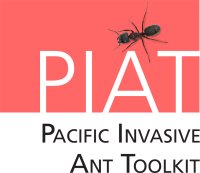Prevention
If they become established invasive ants may have a negative impact on the environment, agriculture or human well being, particularly if they reach high abundance. Attempts to eradicate or control established invasive ant populations can be expensive and labour intensive, and are frequently unsuccessful. Prevention is always better than cure.
The main audience for this section of the toolkit are biosecurity / quarantine officers, who want to find out how to prevent ant problems.
The SPREP / SPC Guidelines for Invasive Species Management in the Pacific and the IUCN Guidelines for invasive species planning and management on islands (which is based on SPREP / SPC Guidelines) both provide a framework for prevention (section C):
- Pre-export: develop and implement improved inspection, treatment, packing and transportation procedures and methods, for transport leaving countries and islands harbouring priority invasive species
- Pre-border: implement a rigorous process of risk analysis in relation to the deliberate introduction of species and the movement of potential carrier goods between countries, and between islands within a country
- At-border: establish and maintain effective quarantine, transport and border control systems at national borders and between islands within countries
- Post-border: establish and maintain effective systems to detect incursions of invasive species reliably and quickly, and mount rapid responses to them.
Key to prevention is getting everyone in the community and visitors to understand the important part they play in biosecurity.
SPREP commissioned Cas Vanderwoude to recommend biosecurity improvements for French Polynesia to address the little fire ant problem. The approaches suggested are applicable to the wider Pacific.
Australia has recently released a comprehensive Biosecurity Plan for invasive ants 2018-2028.
Biosecurity Plans
Boudjelas, Froud. 2016. Biosecurity Plan for Ouvea Atoll, Loyalty islands, New Caledonia. Prepared for the Pacific Community. Available at: https://integre.spc.int/images/telechargements/Ouvea_Biosecurity_Plan_FINAL.pdf
Environment and Invasives Committee. 2019. National Invasive Ant Biosecurity Plan Australian Government, Canberra. Available at: www.environment.gov.au/biodiversity/threatened/publications/tap/invasive-ants
United States Department of Agriculture. 2019. Imported Fire Ant Program Manual. Available at: https://www.aphis.usda.gov/aphis/ourfocus/planthealth/plant-pest-and-disease-programs/pests-and-diseases/imported-fire-ants/ct_imported_fire_ants.
Other information sources
The SPREP / SPC Guidelines for invasive species management in the Pacific
The IUCN Guidelines for invasive species planning and management on islands
Vanderwoude. 2013. Extension of the biosecurity monitoring programme in French Polynesia and its trading partners, with a focus on the little fire ant. Report to SPREP
